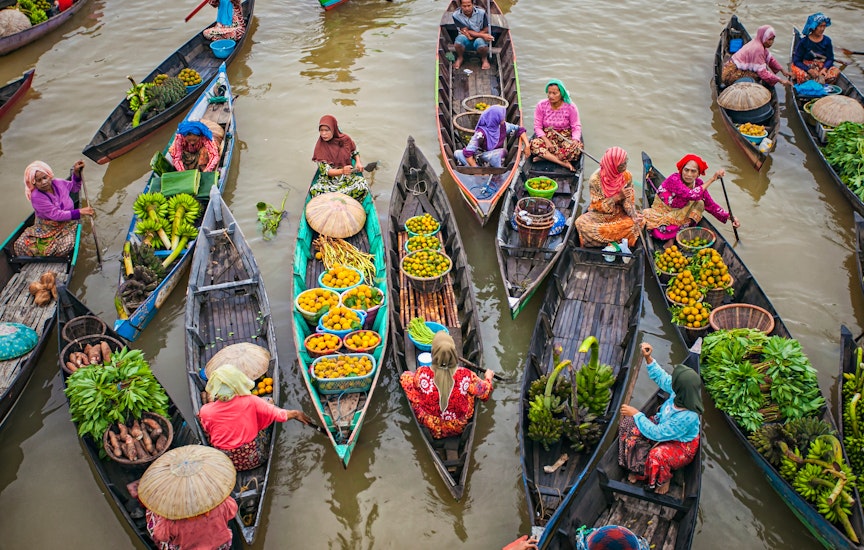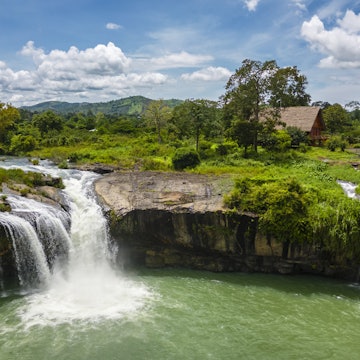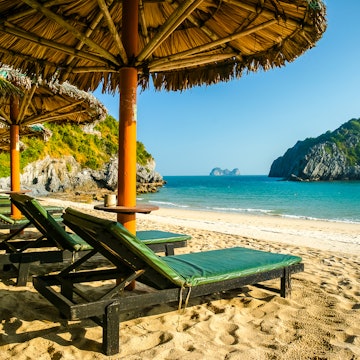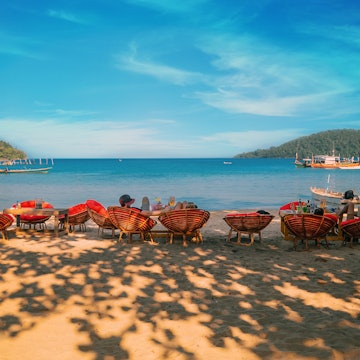

A kapal biasa ferry. Mr.ardi/Shutterstock
Traveling the Sungai Mahakam – the Mahakam River – is a once-in-a-lifetime experience. The waterway takes travelers deep into the interior of Kalimantan – the Indonesian portion of Borneo – via tiny riverine towns and villages of the Indigenous Dayak people, and along jungle-lined, wildlife-rich channels.
In this part of the world, you’ll hear very little English spoken, and shouldn’t expect much in the way of comfort. Yet above all, this is an adventure where the journey is as important as the destination – and one you’ll never forget.
Here’s what you need to know as you plan your trip, and once you’ve set out.
What kind of boats ply the Sungai Mahakam?
You’ll find a variety of vessels on the waters of the mighty Mahakam.
Kapal biasa: The workhorses of the Sungai Mahakam, these double-decker ferries make multiday journeys from Samarinda to Long Bagun. The open lower deck is for short-distance travelers, cargo, fuel and motorbikes. Long-distance passengers travel on the enclosed upper deck.
Speedboats: Known as spid, these powerful motorboats skim along the Mahakam at speeds of 40 knots per hour (about 75 km/h). Spids are noisy and cramped, especially for tall or large people.
Ces: Pronounced “chess,” these are the Indonesian version of the long-tail boats found across Southeast Asia. They’re perfect for exploring narrow jungle waterways and for spotting wildlife.
How much does it cost to travel along the Sungai Mahakam?
For kapal biasa tickets, expect to pay between 100,000 Indonesian rupiah and 200,000Rp per leg between major towns along the Mahakam. A ces will run you about 1,500,000Rp per day. You can hire a guide for about 600,000Rp per day.

How long does it take to travel up the Sungai Mahakam?
You could get all the way from Samarinda to Long Bagun via kapal biasa in three days, but you’d be on the boat for almost the entire time. We recommend taking a week or even 10 days to enjoy the wildlife, small villages and sleepy pace of life along the river.
Where does the Sungai Mahakam journey begin?
You’ll set out at Samarinda, the capital of East Kalimantan province, at the delta of the mighty Sungai Mahakam. The city’s Islamic Center is the largest mosque in Kalimantan, and looks splendid when lit up at night (visitors can climb an adjacent observation tower for awesome river views). Apart from the busy main market, Pasar Pagi, there’s little else to see in the town. As you gear up for your Mahakam journey, you’ll find plenty of accommodation, dining and shopping options close to the always-lively riverfront.
Detour: If you’re not taking to the river, Samarinda also acts as a gateway to Kutai National Park, a five-hour drive to the north via the town of Sangatta. All but abandoned in the 1990s, Kutai has bounced back and 2000 wild orangutans are now estimated to live here, as well as proboscis monkeys, gibbons, langurs, clouded leopards, large monitor lizards and numerous species of orchids.
How does the journey along the Sungai Mahakam proceed?

First port of call: Tenggarong
Two kapal biasa chug out of Samarinda daily at 7am from a riverfront dock almost opposite Samarinda’s bus station; buy tickets on board. From there, it’s a short journey along the wide and mud-brown Mahakam to Tenggarong, the boat’s first stop.
Bustling Tenggarong sprawls along the banks of the river and comes off as unremarkable at first sight. Yet this is the former capital of the once-mighty Sultanate of Kutai (whose first permutation, a Hindu realm in the 4th century CE, is thought to be the oldest of all Indonesia’s kingdoms). The former sultan’s palace is partially open to visitors, while the next-door Mulawarman Museum chronicles the culture and history of the Kutai kingdom and has some impressive Yuan and Ming dynasty ceramics.
Planning tip: Try to be in Tenggarong for the Erau International Folk & Art Festival. Normally held in August or September, it’s an annual celebration of local cultures that draws a big crowd, with events held at the palace and around town. Note that Tenggarong’s handful of hotels book up at this time.

Onward to Kota Bangun
A few hours upriver from Tenggarong lies Kota Bangun, a town that drowses in the afternoon sun, its low-rise wooden houses dominated by the riverfront mosque. There are a couple of simple guesthouses and a few restaurants here, all closed by 9pm. Any foreigner attracts a lot of attention.
If you do come here by kapal biasa, it’s worth getting off and traveling on by ces – wooden canoe-like vessels with lawnmower-like engines and a tarp for a roof. After Kota Bangun, endless wildlife-rich tributaries branch off the river, leading to intriguing villages that you won’t see from the big ferries. Local boatmen hang out at a jetty on the Kota Bangun riverfront; negotiate a day-long ride with one of them to take you to the next town, Muara Muntai, via the lakes and wetlands of the Mahakam’s Lake District.
Planning tip: The journey along the Lower Mahakam to Kota Bangun is scenically the least interesting stretch of the river journey, and the waterway is always busy with giant barges hauling coal to the coast from the mines upriver. Some people choose to travel this section by bus or car, picking up boats again in Kota Bangun to head onward to a world of sleepy riverine settlements.

Slow down to savor nature in the Lake District
Swapping the kapal biasa for a low-slung ces brings you closer to nature almost immediately. If you speak some Bahasa Indonesia, the boatmen can also act as guides. They’re quick to spot hornbills or monkeys, and will take you to the places you’re most likely to encounter them.
Soon after leaving Kota Bangun, the village of Muara Pela appears on the left of the river, with lakes and wetlands visible in the far distance. This is the prime place for spotting the Mahakam’s dwindling population of river dolphins, and boatmen will circle in search of them. After that, your ces will bounce across the big expanse of Lake Semayang.
On the other side of the lake is Melintang, an entirely stilted settlement perched over the water and connected to the mainland by a precarious bamboo bridge. From here, boatmen turn into narrow tributaries of the Mahakam, where the forest reaches over the water, passing small villages on the way into Muara Muntai.

Follow Muara Muntai’s boardwalks to Lake Jempang
Instead of footpaths, the riverside town of Muara Muntai is connected by a network of ironwood boardwalks, down which motorbikes clack constantly. A heavily Muslim town, Muara Muntai has a couple of guesthouses and restaurants and makes a fine base for exploring Lake Jempang, the largest of the three wetlands in the Lake District, as well as the surrounding Dayak villages.
Lake Jempang is a bird-watcher’s paradise: look out for kingfishers, hornbills and storks. But as your ces heads out of Muara Muntai toward the lake, you’ll note that it’s proboscis monkeys that dominate the trees. You’ll almost certainly see the big-nosed, long-tailed primates gamboling along the riverbank, and occasionally even swimming in the river.
Across the lake is Tanjung Isay, a small Dayak village with a historic longhouse, Louu Taman Jamrud, guarded by carved totems. (It’s possible to stay there.) In nearby Mancong Village is the exquisitely restored 1930s Mancong Longhouse. If water levels permit, you can get to Mancong by boat; otherwise, hop on a motorbike in Tanjung Isay for the 10km ride.

Meet proboscis monkeys on the way to Melak
The four-hour journey by ces from Muara Muntai to Melak sees boats weaving around vast clumps of water hyacinth on Lake Jempang, before turning down a winding channel lined with giant banyan trees. The proboscis monkeys are just meters away here, along with macaques and monitor lizards, while brightly colored birds fly overhead and the insects in the jungle chatter incessantly. Boats rejoin the Mahakam at Muara Pahu, a collection of stilted villages, before heading into Melak.
There are Dayak villages and the odd longhouse around Melak, the largest town on the Mahakam after Tenggarong. (Thirsty travelers will also find a couple of liquor stores here.) If you want to avoid taking the much slower kapal biasa, two daily spids (speedboats) leave Melak for Samarinda around 9am, zooming down the river in a spine-compressing six hours.
Encounter Dayak culture in Tering
Deep into gold-mining country, Tering is really two villages divided by the Mahakam. Tering Baru is a Malay settlement where kapal biasa dock. Much more interesting is the Dayak community of Tering Lama on the north bank of the river. Hop a ces across the river to see Tering Lama’s magnificent Catholic church, an all-wood structure with a bell tower suspended from towering pillars and carved totems outside the entrance.
Tering, an hour’s drive from Melak, is sometimes the final stop for kapal biasa, depending on water levels. If the kapal can’t move on, travelers can catch a morning spid here for the four-hour journey on to Long Bagun.
Finish up the journey in remote Long Bagun
Travelers who make it to Long Bagun can congratulate themselves: this is the final stop for the Mahakam’s kapal biasa. There’s only one more settlement upriver: the village of Tiong Ohang, a six-hour ride in a spid, from where Cross-Borneo trekkers march off into the Muller Range.
Long Bagun is a small but interesting majority-Dayak village with an attractive longhouse. If water levels are right, kapal biasa dock 3km south of the village at Ujoh Bilang. Otherwise spids make the journey downriver to Tering.

Top tips for your Sungai Mahakam journey
Though guides aren’t essential for the journey, they will make your life much easier if you don’t speak any Bahasa Indonesia.
There are ATMs in Muara Muntai and Melak, but you shouldn’t rely on them. Have plenty of cash on you before you set out.
Speedboats heading upriver or downriver normally depart between 8am and 9am. Buy tickets the day before.
Kapal biasa dock and depart at all hours. Don’t expect them to be on time.
Samarinda-based De’Gigant Tours offers multiday tours of the Mahakam in comfortable klotok houseboats.

Will I see river dolphins along the Sungai Mahakam?
Alas, probably not, since there are now thought to be fewer than 70 river dolphins remaining in the Sungai Mahakam (but you never know…). Genetically different from the Irrawaddy dolphins found in Southeast Asia’s other major rivers, the gray-blue, snub-nosed dolphins face the twin threats of fishing nets and boat engines, as well as a river increasingly polluted with coal-mine and palm-oil-plantation runoff. Samarinda-based NGO YK-RASI works to protect these enchanting creatures.
This article was adapted from Lonely Planet’s Indonesia guidebook, published in July 2024.















